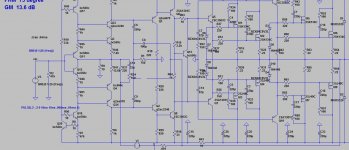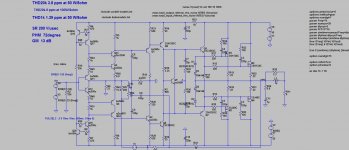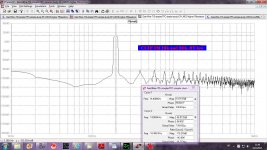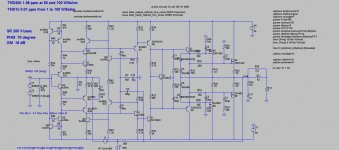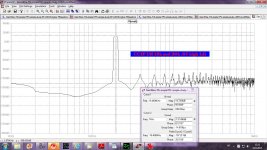Good distortion results and slew rate on your design dadod.
The original design is from Manso IIRC , yet there s no indication
of this in the opening post.....
The original design is from Manso IIRC , yet there s no indication
of this in the opening post.....
If you read CFA thread you can see there that manso design is the one I came back after some circles http://www.diyaudio.com/forums/solid-state/240712-cfa-topology-audio-amplifiers-133.html#post3647137. It is a bit different specially type of compensation. This one is just more powerful version of the mosfet version I presented there.
Last edited:
This design topology is a natural end point in CFA design.
I ended up with a similar design independent of Manso's design.
Edit: Wonder if the TPC compensation can be simplified (as it is symmetrical) a little to reduce component count and reduce compensation based VAS fighting.
I ended up with a similar design independent of Manso's design.
Edit: Wonder if the TPC compensation can be simplified (as it is symmetrical) a little to reduce component count and reduce compensation based VAS fighting.
This design topology is a natural end point in CFA design.
I ended up with a similar design independent of Manso's design.
Edit: Wonder if the TPC compensation can be simplified (as it is symmetrical) a little to reduce component count and reduce compensation based VAS fighting.
Actually it's possible, I did it in the VSSA thread before.
Here is simpler TPC.
Attachments
Actually it's possible, I did it in the VSSA thread before.
Here is simpler TPC.
This is exactly what I had in mind.
Here is low power versions of LMOS CFA amp with simplified TPC, one with lower loop gain(LG – 78 db up to 10kHz) and one with higher LG(120 dB up to 1kHz).
High power AMP should give even better result.
It is interesting to see IMD for those two different LG.
Input signals 19kHz and 20kHz amplitude 1.2Vpp.
IMD for lower LG is 116 dB and for higher LG it is 157 dB
Does more complication is worth much lower IMD??
Damir
High power AMP should give even better result.
It is interesting to see IMD for those two different LG.
Input signals 19kHz and 20kHz amplitude 1.2Vpp.
IMD for lower LG is 116 dB and for higher LG it is 157 dB
Does more complication is worth much lower IMD??
Damir
Attachments
I see this idea has resurfaced and you've found a better compensation method.
It's interesting to note the IMD differences. You should reference this in the CFA thread.
Have you found a way of extending the LG up further than 1KHz in the more complex version. Its not easy, I've found.
It's interesting to note the IMD differences. You should reference this in the CFA thread.
Have you found a way of extending the LG up further than 1KHz in the more complex version. Its not easy, I've found.
I see this idea has resurfaced and you've found a better compensation method.
It's interesting to note the IMD differences. You should reference this in the CFA thread.
Have you found a way of extending the LG up further than 1KHz in the more complex version. Its not easy, I've found.
No I did not, I think that there is the pole at the same frequency, just shunted in low LG amp.
I don't think that it's important as IMD is normaly manifestad at lower frequences, imput filter should prevent to high frequiences input the amp(maybe better input filter as Edmond suggested before).
It would be good to get the loop gain flat out to 5KHz so we could achieve flat THD performance up to this frequency.
Loop gain of 120dB is up there with the VFAs.
Loop gain of 120dB is up there with the VFAs.
It would be good to get the loop gain flat out to 5KHz so we could achieve flat THD performance up to this frequency.
Loop gain of 120dB is up there with the VFAs.
Yes, but don't forget distortion at 1 kHz .000001%, I never seen that in VFA amp simulation.
Yes, but don't forget distortion at 1 kHz .000001%, I never seen that in VFA amp simulation.
It would be interesting to see how this would work in a real circuit.
Reckon that the cost of 4 transistors and a few resistors is a small price to pay for all that extra LG.
I know that it works in reality but have no measurement equipment yet.
Yes, but don't forget distortion at 1 kHz .000001%, I never seen that in VFA amp simulation.
What is it at the 200 watt level? and at 20khz
What is it at the 200 watt level? and at 20khz
Look first two post, everything is written on the schematics.
My VAS does it - at least, one of the latest complete schematics. 0.000000% @ 1K / 1WYes, but don't forget distortion at 1 kHz .000001%, I never seen that in VFA amp simulation.
My VAS does it - at least, one of the latest complete schematics. 0.000000% @ 1K / 1W
But that was at 100W or 200W for powerful version.
This is the kind of CMA discussion I think moves things along.... and higher power than 50W is really needed IMO.
I have a question... what would be done to double the SR without incurring any significant affects on performance?
Thx-RNMarsh
I have a question... what would be done to double the SR without incurring any significant affects on performance?
Thx-RNMarsh
Last edited:
This is the kind of CMA discussion I think moves things along.... and higher power than 50W is really needed IMO.
I have a question... what would be done to double the SR without incurring any significant affects on performance?
Thx-RNMarsh
Sorry Richard for my ignorance, SR means?
BR Damir
what does the sim give for distortion if Q34 emitter is connected to 22 ohm feedback resistor
Sim with a servo op amp eliminating output offset.
high side VAS current source fixed at 10 ma.
I have been using an amp like that for 15 years
Sim with a servo op amp eliminating output offset.
high side VAS current source fixed at 10 ma.
I have been using an amp like that for 15 years
what does the sim give for distortion if Q34 emitter is connected to 22 ohm feedback resistor
Sim with a servo op amp eliminating output offset.
high side VAS current source fixed at 10 ma.
I have been using an amp like that for 15 years
Sorry, I don't understend, could you be morre specific? How to connect Q34 emitter to the 22 ohm FB resistor, what happens with Q4?
- Home
- Amplifiers
- Solid State
- 200W MOSFET CFA amp
